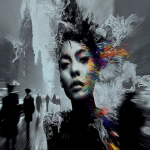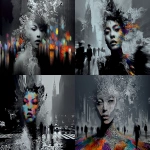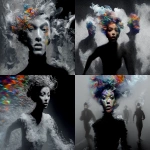Explore the Best AI Image Gallery

Beyond Reality: How VR and AR are Transforming Gaming and the Creative Industry
The landscape of entertainment and creativity is being redefined by virtual reality (VR) and augmented reality (AR). These immersive technologies are not just captivating gamers, but also transforming how we create, experience, and interact with the world around us.
A New Playground for Gaming
VR gaming has taken us beyond passive spectators to active participants in digital worlds. From exploring fantastical realms in Oculus Quest 2 titles like Beat Saber to embarking on epic quests in Half-Life: Alyx, VR offers unparalleled levels of immersion and interactivity.
AR, on the other hand, overlays digital elements onto the real world. Games like Pokémon GO demonstrated the power of AR to engage players with their surroundings. Imagine exploring a historical site and having virtual characters come to life, narrating events or interacting with you as if they were present.
The Creative Canvas Expands
VR and AR are revolutionizing creative industries beyond gaming:
- Design and Architecture: Architects can now walk through virtual buildings before theyre built, visualizing layouts, materials, and spatial experiences.
- Filmmaking and Storytelling: Directors can pre-visualize shots, collaborate with actors in virtual sets, and create immersive cinematic experiences for audiences.
- Art and Expression: VR allows artists to create interactive installations, sculpt in 3D space, and share their work in entirely new ways. AR can transform public spaces into canvases for art, allowing viewers to interact with projections or augmented sculptures.
Ethical Considerations
As with any powerful technology, VR and AR raise ethical considerations:
- Privacy: AR relies on data collection about users environments. Ensuring responsible data handling and user consent is crucial.
- Addiction and Dependence: The immersive nature of VR can lead to excessive use and potential addiction. Its important to promote balanced engagement and address potential negative impacts on mental health.
- Digital Divide: Access to VR and AR technologies may not be equal, potentially exacerbating existing inequalities.
Future Trends
The future of VR and AR in gaming and the creative industry is bright:
- Increased Realism and Immersion: Advancements in graphics, haptics (touch feedback), and sensory technologies will create even more realistic and immersive experiences.
- Wider Accessibility: More affordable VR and AR devices will make these technologies accessible to a broader audience.
- Integration with Other Technologies: VR and AR will seamlessly integrate with AI, blockchain, and other emerging technologies, creating new possibilities for creativity and interaction.
Conclusion
VR and AR are more than just technological advancements; they are tools for reshaping how we play, create, and experience the world. As these technologies continue to evolve, they hold immense potential to unlock new frontiers of imagination and innovation, blurring the lines between reality and virtuality.

](https://images.ai-img.art/thumbnails/150/ff09e32d2be011c0dd785984c5c1e47839ce551a31da1bde242860b30df2aa30.webp)



](https://images.ai-img.art/thumbnails/150/2ebdeb4f7db35100e5be5de9bc3e533a40d14e5feedefd7ffc586524a0f3ba8c.webp)

](https://images.ai-img.art/thumbnails/150/7cf5a08238f29c821f52bb4f63db48af0b7f633ff3b9f7253074d78ced9ff6f6.webp)







](https://images.ai-img.art/thumbnails/150/685ae68cfab93a7e59a71206867b060c45bd6fd3cd561c4fe60fca514b09c5f8.webp)

](https://images.ai-img.art/thumbnails/150/847809c77ca9a73b68bc190e6efb06fec87157685a243730d5a66a403b0e6e10.webp)

](https://images.ai-img.art/thumbnails/150/bd056a4718c27444e064198762f8dc8ffa1f74f1afd7dcda8d5cb8b142797d6e.webp)


















](https://images.ai-img.art/thumbnails/150/a3ed6513a6661aa3ee46e0c2924d1e8888854e91d8908de39db5590dc41f8d8f.webp)








](https://images.ai-img.art/thumbnails/150/0ba0be922ab76af53f75ab90126ae2b18a600ee3b96941e8ab897a9f10594e5a.webp)

